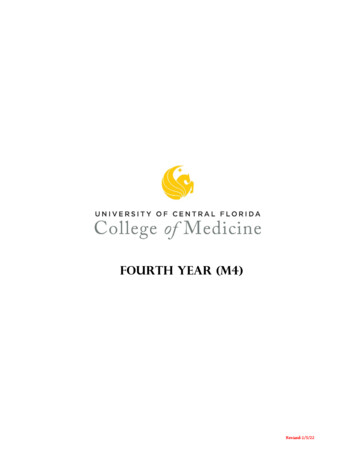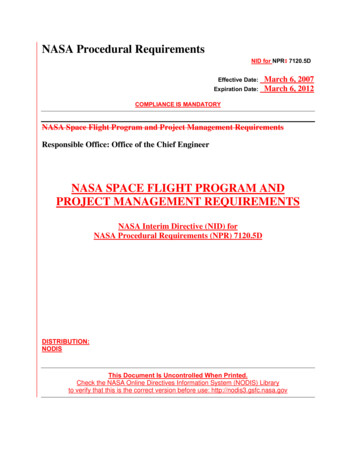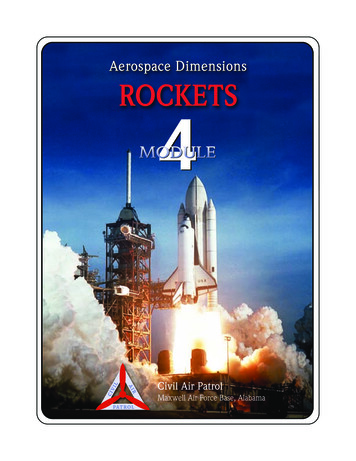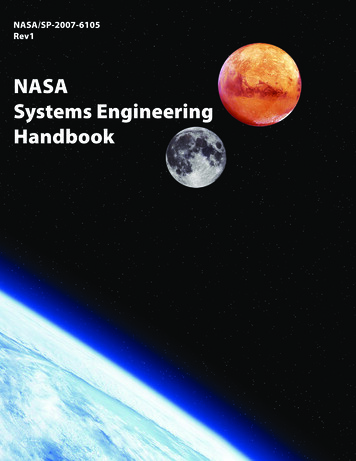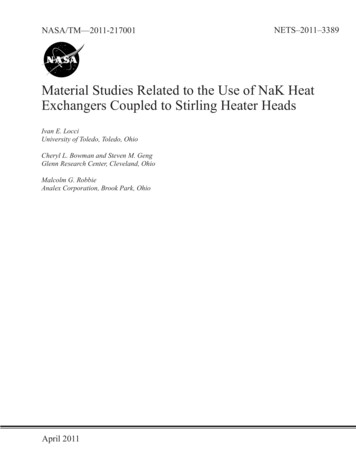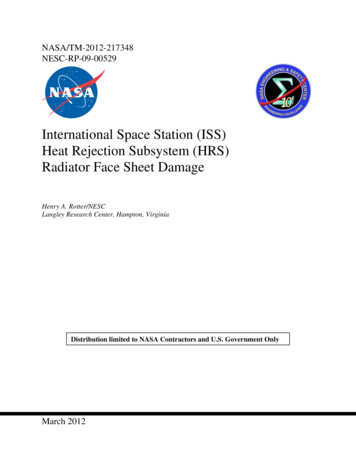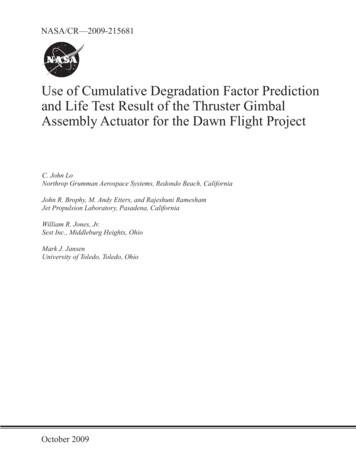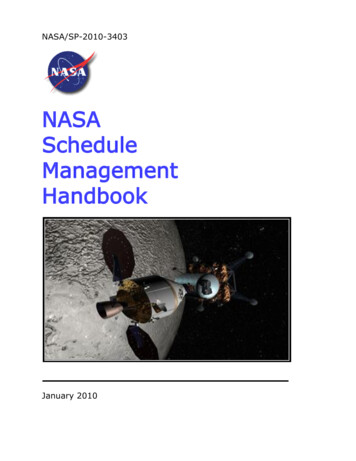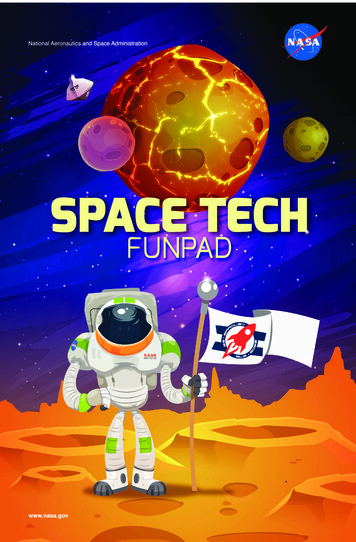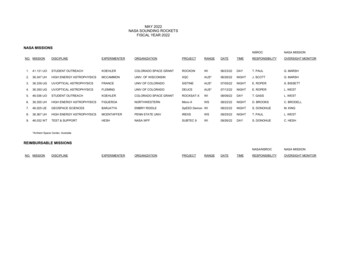
Transcription
MAY 2022NASA SOUNDING ROCKETSFISCAL YEAR 2022NASA MISSIONSNO. NGEDATETIMENSROCNASA MISSIONRESPONSIBILITYOVERSIGHT MONITOR1.41.131 UOSTUDENT OUTREACHKOEHLERCOLORADO SPACE GRANTROCKONWI06/23/22DAYT. PAULG. MARSH2.36.347 UHHIGH ENERGY ASTROPHYSICSMCCAMMONUNIV. OF WISCONSINXQCAUS*06/26/22NIGHTJ. SCOTTG. MARSH3.36.339 UGUV/OPTICAL ASTROPHYSICSFRANCEUNIV OF COLORADOSISTINEAUS*07/05/22NIGHTE. ROPERS. BISSETT4.36.350 UGUV/OPTICAL ASTROPHYSICSFLEMINGUNIV OF COLORADODEUCEAUS*07/12/22NIGHTE. ROPERL. WEST5.46.036 UOSTUDENT OUTREACHKOEHLERCOLORADO SPACE GRANTROCKSAT-XWI08/09/22DAYT. GASSL. WESTWS6.36.355 UHHIGH ENERGY ASTROPHYSICSFIGUEROANORTHWESTERNMicro-X7.46.025 UEGEOSPACE SCIENCESBARJATYAEMBRY RIDDLESpEED Demon WI08/22/22NIGHTD. BROOKSC. BRODELL08/22/22NIGHTS. DONOHUEM. KING8.36.367 UHHIGH ENERGY ASTROPHYSICSMCENTAFFERPENN STATE UNIVtREXSWS09/25/22NIGHTT. PAULL. WEST9.46.032 WTTEST & SUPPORTHESHNASA WFFSUBTEC 9WI09/26/22DAYS. DONOHUEC. HESHNASA/NSROCNASA MISSIONRESPONSIBILITYOVERSIGHT MONITOR*Arnhem Space Center, AustraliaREIMBURSABLE MISSIONSNO. NGEDATETIME
MAY 2022NASA SOUNDING ROCKETSFISCAL YEAR 2023NASA MISSIONSNO. NGEDATETIMENSROCNASA MISSIONRESPONSIBILITYOVERSIGHT MONITOR1.36.337 DSSOLAR & HELIOSPHERICCRUMPNRLVERIS 2WS10/25/22DAYT. GASSC. BRODELL2.12.089 WTTEST ROUNDEDWARDSNASA/WFFMesOrionWI11/01/22DAYT. PAULC. MILLINER3.12.090 WTTEST ROUNDEDWARDSNASA/WFFMesOrionWI11/01/22DAYT. PAULC. MILLINER4.36.359 UEGEOSPACE SCIENCESBOUNDSUNIV OF IOWAACES-2NOR11/16/22NIGHTJ. SCOTTL. WEST5.36.364 UEGEOSPACE SCIENCESBOUNDSUNIV OF IOWAACES-3NOR11/16/22NIGHTJ. SCOTTL. WEST6.36.383 UGUV/OPTICAL ASTROPHYSICSZEMCOVRITCIBERWS01/27/23NIGHTS. DONOHUEC. MILLINER7.36.361 UEGEOSPACE SCIENCESLEMACHERCLEMSON UNIVVortEXNOR02/10/23NIGHTE. ROPERS. BISSETT8.36.362 UEGEOSPACE SCIENCESLEMACHERCLEMSON UNIVVortEXNOR02/10/23NIGHTE. ROPERS. BISSETT9.41.127 UEGEOSPACE SCIENCESLEMACHERCLEMSON UNIVVortEXNOR02/10/23NIGHTE. ROPERS. BISSETTNOR10. 41.128 UEGEOSPACE SCIENCESLEMACHERCLEMSON UNIVVortEX02/10/23NIGHTE. ROPERS. BISSETT11. 45.007 GEGEOSPACE SCIENCESBENNANASA/GSFCDISSIPATION FB02/12/23NIGHTE. ROPERD. BOWDEN12. 52.009 AEGEOSPACE SCIENCESREEVESLOS ALAMOS NATIONAL LABBeam-PIE02/12/23NIGHTJ. SCOTTG. MARSHFB13. 46.034 UEGEOSPACE SCIENCESCONDEUNIV OF ALASKAAWESOMEFB03/13/23NIGHTS. DONOHUEM. KING14. 46.035 UEGEOSPACE SCIENCESCONDEUNIV OF ALASKAAWESOMEFB03/13/23NIGHTS. DONOHUEM. KING15. 52.010 UEGEOSPACE SCIENCESCONDEUNIV OF ALASKAAWESOMEFB03/13/23NIGHTS. DONOHUEM. KING16. 36.384 UGUV/OPTICAL ASTROPHYSICSMCCANDLISSJOHNS HOPKINSOAxFORTISWS04/10/23NIGHTS. DONOHUEL. WEST17. 36.375 UGUV/OPTICAL ASTROPHYSICSFLEMINGUNIV OF COLORADOINFUSEWS04/24/23NIGHTE. ROPERL. WEST18. 36.366 USSOLAR & HELIOSPHERICKANKELBORGMONTANA STATE UNIVFURSTWS05/22/23DAYS. DONOHUEC. MILLINER19. 46.026 UEGEOSPACE SCIENCESBARJATYAEMBRY RIDDLESEEDKWAJ06/16/23NIGHTE. ROPERL. WEST20. 46.037 UEGEOSPACE SCIENCESBARJATYAEMBRY RIDDLESEEDKWAJ06/16/23NIGHTE. ROPERL. WEST21. 36.385 NSSOLAR & HELIOSPHERICWINEBARGERNASA/MSFCMaGIXS 2WS08/01/23DAYT. PAULD. BOWDEN22. 36.335 CEGEOSPACE SCIENCESCLEMMONSAEROSPACE CORP.TOMEX-PlusWI08/08/23NIGHTT. GASSS. BISSETT23. 41.123 CEGEOSPACE SCIENCESCLEMMONSAEROSPACE CORP.TOMEX-PlusWI08/08/23NIGHTT. GASSS. BISSETT24. 41.124 CEGEOSPACE SCIENCESCLEMMONSAEROSPACE CORP.TOMEX-PlusWI08/08/23NIGHTT. GASSS. BISSETT25. 36.382 UEGEOSPACE SCIENCESGILCHRISTUNIV OF MICHIGANB-SPICEWS09/17/23NIGHTD. BROOKSM. KINGNASA/NSROCNASA MISSIONRESPONSIBILITYOVERSIGHT MONITORT. PAULG. MARSHREIMBURSABLE MISSIONSNO. MISSION1.36.354 TEDEFENSE REIMBURSABLEKRUEGERMDASOFE-1WI02/01/23TIME
MAY 2022NASA SOUNDING ROCKETSFISCAL YEAR 2024NASA MISSIONSNO. NGEDATETIMENSROCNASA MISSIONRESPONSIBILITYOVERSIGHT MONITOR1.36.386 UEGEOSPACE SCIENCESBARJATYAEMBRY RIDDLE UNIVERSITYApophisWS10/01/23DAYJ. SCOTTM. KING2.36.387 UEGEOSPACE SCIENCESBARJATYAEMBRY RIDDLE UNIVERSITYApophisWS10/01/23DAYJ. SCOTTM. KING336.388 UEGEOSPACE SCIENCESBARJATYAEMBRY RIDDLE UNIVERSITYApophisWS10/01/23DAYJ. SCOTTM. KING4.36.380 GEGEOSPACE SCIENCESMICHELLGSFCGIRAFFFB02/05/24NIGHTT. PAULD. BOWDEN5.36.381 GEGEOSPACE SCIENCESMICHELLGSFCGIRAFFFB02/05/24NIGHTT. PAULD. BOWDEN636.298 UHHIGH ENERGY ASTROPHYSICSMCENTAFFERPENN STATE UNIVOGREFB02/06/24NIGHTT. GASSC. HESH7.36.372 USSOLAR AND HELIOSPHERICCHAMBERLINUNIV OF COLORADOSNIFSFB03/19/24DAYT. PAULD. BOWDEN8.36.370 USSOLAR AND HELIOSPHERICGLESENERUNIV OF MINNESOTAFOXI-4FB03/29/24DAYT. GASSG. MARSH936.371 NSSOLAR AND HELIOSPHERICSAVAGENASA MSFCHI-C FlareFB03/29/24DAYS. DONOHUEL. WESTNASA/NSROCNASA ERESPONSIBILITYOVERSIGHT MONITORREIMBURSABLE MISSIONSNO. MISSIONDISCIPLINE
MAY 2022NASA SOUNDING ROCKETSFISCAL YEAR 2025NASA MISSIONSNO. MISSION1.52.011 UENSROCNASA NGEDATETIMERESPONSIBILITYOVERSIGHT MONITORGEOPACE SCIENCELESSARDUNIV OF NEW HAMPSHHIRERENU 3NOR11/01/24NIGHTJ. SCOTTM. KINGNASA/NSROCNASA MISSIONREIMBURSABLE MISSIONSNO. NGEDATETIMERESPONSIBILITYOVERSIGHT MONITOR1.36.376 NRNASA REIMBURSABLEJACKMANNASA MSFC & JPLMAV-FTWI10/01/24DAYT. PAULG. MARSH2.45.008 NRNASA REIMBURSABLEO'FARRELLNASA JPLASPIRE 2WI01/01/25DAYJ. SCOTTL. WEST
NASA SOUNDING ROCKETSMISSIONS LAUNCHEDFISCAL YEAR 2022NASA MISSIONSNO. MISSIONFLIGHT RESULTSDISCIPLINEEXPERIMENTER ORGANIZATIONPROJECT RANGEDATETIME (Z)NSROCRESPONSIBILITYNASA MISSIONOVERSIGHTMONITORVEHICLEPL )SUCCESS1.36.374 NSSOLAR & :40:00S. DONOHUED. BOWDENSSSS2.36.373 UGUV/OPTICAL ASTROPHYSICSFRANCEUNIV OF COLORADOSISTINE 2WS11/08/2109:25:00D. BROOKSD. BOWDENSSSS3.49.004 UEGEOSPACE SCIENCECONDEUNIV OF ALASKAC-REX 2NOR12/01/2109:25:00S. DONOHUED. BOWDENSSSSSSSSS4.36.363 UHHIGH ENERGY ASTROPHYSICSGALEAZZIUNIV OF MIAMIDXL 3WI01/04/2205:00:00T. PAULC. BRODELL5.36.351 GEGEOSPACE SCIENCESHALFORDGSFCLAMPFB03/05/2211:27:30J. SCOTTG. MARSHSSSS. HESHSSFFSSSS6.36.307 DSSOLAR & HELIOSPHERICTUNNAVAL RESEARCH LABHERSCHELWS03/09/2218:25:00T. PAUL7.36.360 UEGEOSPACE SCIENCESKAEPPLERCLEMSON UNIVERSITYINCAAFB04/07/2212:47:00E. ROPERG. MARSH8.46.031 UEGEOSPACE SCIENCESKAEPPLERCLEMSON UNIVERSITYINCAAFB04/07/2212:50:00E. ROPERG. MARSHSSSS9.47.001 GEGEOSPACE T. GASSS. BISSETTSSSSNSROCRESPONSIBILITYNASA MISSIONOVERSIGHTMONITORVEHICLEPL SUPPORTSYSTEMST. GASSL. WESTSSREIMBURSABLE MISSIONSNO. MISSION1.46.027 DRFLIGHT RESULTSDISCIPLINEEXPERIMENTER ORGANIZATIONDEFENSE REIMBURSABLEHOLDENUSAF* MISSION IS SUCCESSFUL UNLESS THERE IS AN "F" IN ANY FLIGHT RESULT COLUMN* N/A DENOTES NOT APPLICABLE IN MISSION SUCCESS/FAILURE ASSESSMENTPROJECT RANGEBOLT-2WIDATE03/21/22TIME CCESSSS
NASA SOUNDING ROCKETSMISSIONS LAUNCHEDFISCAL YEAR 2021NASA MISSIONSNO. MISSION1.36.368 UGFLIGHT RESULTSDISCIPLINEEXPERIMENTER ORGANIZATIONUV/OPTICAL ASTROPHYSICSGREENUNIV OF COLORADOPROJECT RANGEDEUCEWSDATE11/02/20TIME CCESSNSROCRESPONSIBILITYNASA MISSIONOVERSIGHTMONITORE. ROPERC. HESHSSSSSSSSSSVEHICLEPL SUPPORTSYSTEMS2.36.324 USSOLAR & HELIOSPHERICHARRISUNIV OF ARIZONAWS04/19/2108:30:00T. GASSG. MARSHS3.52.007 UEGEOSPACE SCIENCESDELAMEREUNIV OF ALASKA FAIRBANKS KiNET-XWI05/07/2100:44:00J. SCOTTC. BRODELLS4.36.322 GSSOLAR & HELIOSPHERICDAWNASA/GSFCWS05/18/2117:30:00T. PAULG. MARSHSSSSSSSSSSSHIELDSEUNIS5.46.028 UEGEOSPACE SCIENCESBONNELLUNIV. OF BERKELEYVIPERWI05/27/2101:15:00S. DONOHUEC. HESHS6.36.281 UGUV/OPTICAL ASTROPHYSICSZEMCOVRITCIBER-2WS06/07/2106:25:00E. ROPERC. MILLINERS7.41.130 UOSTUDENT OUTREACHKOEHLERCOLORADO SPACE GRANTROCKONWI06/25/2112:32:00T. PAULG. MARSHSSSSSSS8.36.358 GEGEOSPACE SCIENCESPFAFFGSFCDYNAMO-2WI07/07/2118:00:00T. GASSC. MILLINERS9.36.357 GEGEOSPACE SCIENCESPFAFFGSFCDYNAMO-2WI07/11/2117:56:00T. GASSC. MILLINERSSSSSSSS10. 36.319 NSSOLAR & HELIOSPHERICWINEBARGERNASA/MSFCMaGIXS11. 46.030 UOSTUDENT OUTREACHKOEHLERCOLORADO SPACE GRANTROCKSAT-X WI12. 36.353 USSOLAR & HELIOSPHERICWOODSUNIV OF COLORADOEVEWSWS07/30/2118:20:00J. SCOTTL. WEST08/19/2121:00:00S. DONOHUEL. WESTSSSST. GASSL. WESTSSSSNSROCRESPONSIBILITYNASA MISSIONOVERSIGHTMONITORE. ROPERC. BRODELLSSSSM. KINGSSSS09/09/2117:25:00REIMBURSABLE MISSIONSNO. MISSION1.2.12.088 NR46.033 ARFLIGHT RESULTSDISCIPLINEEXPERIMENTER ORGANIZATIONTEST & SUPPORTGILBERTTECHNOLOGY DEVELOPMENTLEATHENESCSANDIA* MISSION IS SUCCESSFUL UNLESS THERE IS AN "F" IN ANY FLIGHT RESULT COLUMN* N/A DENOTES NOT APPLICABLE IN MISSION SUCCESS/FAILURE ASSESSMENTPROJECT RANGEABFTHOTShotWSWIDATE03/30/2109/11/21TIME (Z)15:00:0022:07:30E. ROPERVEHICLEPL )SUCCESS
NASA SOUNDING ROCKETSMISSIONS LAUNCHEDFISCAL YEAR 2020NASA MISSIONSNO. MISSION1.36.343 GBFLIGHT RESULTSDISCIPLINEEXPERIMENTER ORGANIZATIONLAB ASTRONUTHNASA GSFCPROJECT RANGEDUSTWSDATE10/07/19TIME (Z)NSROCRESPONSIBILITY15:00:00 E. ROPER2.46.020 GTTEST & SUPPORTHESHNASA WFFSUBTEC 8WI10/24/190:00:003.36.352 UGUV/OPTICAL ASTROPHYSICSMCCANDLISSJOHNS HOPKINSFORTISWS10/28/1904:30:00 T. PAUL4.46.029 IEGEOSPACE SCIENCEMOENUNIV OF OSLOICI-5SVAL11/26/19J. SCOTT07:43:04 D. BOWDENNASA MISSIONOVERSIGHTMONITORVEHICLEPL )SUCCESSN. EMPSONSSSSSSSSC. HESHSL. WESTSSSS. BISSETTFSFFSSS5.36.349 UEGEOSPACE SCIENCESLARSENCLEMSON UNIVERSITYCHISVAL12/10/1909:30:00 D. BOWDENG. MARSHS6.36.356 UEGEOSPACE SCIENCESBAILEYVA TECHPolarNOxFB01/26/2013:40:00 J. SCOTTG. MARSHSSSS7.36.365 GBLAB ASTRONUTHNASA GSFCDUST-2WS09/08/2018:00:00 E. ROPERT. THORNESSSSSREIMBURSABLE MISSIONSNO. MISSIONDISCIPLINEFLIGHT RESULTSEXPERIMENTER ORGANIZATION* MISSION IS SUCCESSFUL UNLESS THERE IS AN "F" IN ANY FLIGHT RESULT COLUMN* N/A DENOTES NOT APPLICABLE IN MISSION SUCCESS/FAILURE ASSESSMENTPROJECT RANGEDATETIME (Z)NSROCRESPONSIBILITYNASA MISSIONOVERSIGHTMONITORVEHICLEPL )SUCCESS
NASA SOUNDING ROCKETSMISSIONS LAUNCHEDFISCAL YEAR 2019NASA MISSIONSNO. MISSION1.35.039 GEFLIGHT RESULTSDISCIPLINEEXPERIMENTER ORGANIZATIONGEOSPACE SCIENCEROWLANDNASA GSFCPROJECT RANGEVISIONS 2DATESVAL12/07/182.35.040 GEGEOSPACE SCIENCEROWLANDNASA GSFCVISIONS 2SVAL12/07/183.52.003 UEGEOSPACE SCIENCEKLETZINGUNIVERSITY OF IOWATRICE-2NOR12/08/18TIME (Z)NSROCRESPONSIBILITYNASA MISSIONOVERSIGHTMONITORVEHICLEPL )SUCCESSJ. HICKMANSSSS11:08:00 T. GASSJ. HICKMANSSSS08:26:00 J. SCOTTL. WESTSSSSSSS11:06:00 T. GASS4.52.004 UEGEOSPACE SCIENCEKLETZINGUNIVERSITY OF IOWATRICE-2NOR12/08/1808:28:00 J. SCOTTL. WESTS5.36.331 UGUV/OPTICAL ASTROPHYSICSGREENUNIVERSITY OF COLORADODEUCEWS12/18/1807:46:00 E. ROPERN. EMPSONSSSS6.52.005 UEGEOSPACE SCIENCESLABELLEDARTMOUTH COLLEGECAPER-2NOR01/04/1909:27:00 D. BOWDENN. EMPSONSSSS7.46.018 UOSTUDENT OUTREACHKOEHLERUNIV. OF COLORADORockSat-XNNOR01/13/1909:13:00 M. KINGG. MARSHSSSS8.51.001 UEGEOSPACE SCIENCESLARSENCLEMSON UNIVERSITYAZURENOR04/05/1922:14:00 D. BOWDENB. HALLSSSS9.51.002 UEGEOSPACE SCIENCESLARSENCLEMSON UNIVERSITYAZURENOR04/05/1922:16:00 D. BOWDENB. HALLSSSS10. 36.332 NSSOLAR & HELIOSPHERICMCKENZIENASA MSFCCLASP 2WS04/11/1916:51:00 R. WEAVERN. EMPSONSSSS11. 36.344 UEGEOSPACE SCIENCESHYSELLCORNELL UNIVERSITYTooWINDYKWAJ06/19/1911:28:00 J. SCOTTN. EMPSONSSSSSSSSS12. 36.345 UEGEOSPACE SCIENCESHYSELLCORNELL UNIVERSITYTooWINDYKWAJ06/19/1911:33:00 J. SCOTTN. EMPSON13. 41.126 UOSTUDENT OUTREACHKOEHLERCOLORADO SPACE GRANTRockOnWI06/20/1909:30:00 D. BOWDENG. ROSANOVASSS14. 36.346 UGUV/OPTICAL ASTROPHYSICSFRANCEUNIV. OF COLORADOSISTINEWS08/11/1906:07:00 M. DANOWSKI G. MARSHSSFF15. 46.022 UOSTUDENT OUTREACHKOEHLERCOLORADO SPACE GRANTRockSat-XWI08/12/1909:44:30 T. PAULC. MIILINERSSSS16. 36.320 USSOLAR & HELIOSPHERICKANKELBORGMONTANA STATE UNIVERSITYESISWS09/30/1918:04:00 E. ROPERC. MIILINERSSSSREIMBURSABLE MISSIONSNO. MISSION1.36.340 DRFLIGHT RESULTSDISCIPLINEEXPERIMENTER ORGANIZATIONDODABBETTTOYON RESEARCH CORP.* MISSION IS SUCCESSFUL UNLESS THERE IS AN "F" IN ANY FLIGHT RESULT COLUMN* N/A DENOTES NOT APPLICABLE IN MISSION SUCCESS/FAILURE ASSESSMENTPROJECT RANGEWIDATE09/17/19TIME (Z)9:36:00NSROCRESPONSIBILITYNASA MISSIONOVERSIGHTMONITORT. GASSC. HESHVEHICLEPL (S)SUCCESSSS
Mission Acronyms 2017 - 2023ABFTAerodynamic Buffet Flight TestACCESS #1Absolute Color Calibration Experiment for Standard StarsACES-2Aurora Current and Electrodynamics StructureASPIREAdvanced Supersonic Parachute Inflation Research and ExperimentsAWESOMEAuroral Waves Excited by Substorm Onset Magnectic EventsAZUREAuroral Zone Upwelling Rocket ExperimentB-SPICEBeam-Spacecraft Plasma Interaction and Charging ExperimentBeam-PIEBeam - Plasma Interactions ExperimentCAPER-2Cusp Alfven and Plasma Electrodynamics RocketCHESSColorado High-resolution Echelle Stellar SpectrographCHICusp Heating InvestigationCIBER-2Cosmic Infrared Background ExperimentCLASP-2Chromospheric LAyer Spectro-Polarimeter 2C-REX-2Cusp-Region Experiment 2DEUCEDual-channel Extreme Ultraviolet Continuum SpectrographDUSTDetermining Unknown yet Significant TraitsDXLDiffuse X-ray emission from the Local galaxyESISEUV Snapshot Imaging SpectrographEUNISExtreme Ultraviolet Normal-Incidence SpectrographFORTISFar-ultraviolet Off Rowland-circle Telescope for Imaging and SpectroscopyFOXSIFocusing Optics X-ray Solar ImagerFURSTFull-Sun Ultraviolet Rocket SpecTrographGIRAFFGround Imaging to Rocket investigation of Auroral Fast FeaturesHERSCHELHElium Resonance Scatter in the Corona and HELiosphereINCAAIon-Neutral Coupling During Active AuroraINFUSEINtegral Field far-Ultraviolet Spectroscopic ExperimentISINGLASSIonospheric Structuring: In Situ and Ground based Low Altitude StudieSKiNET-XKinetic-scale Energy and momentum Transport eXperimentLAMPLoss through Auroral Microburst PulsationsMaGIXSMarshall Grazing Incidence X-ray SpectrometerMAV-FTMars Ascent Vehicle - Flight TestOAxFORTISOff Axis Far-ultraviolet Off Rowland-circle Telescope for Imaging and SpectroscopyOGREOff-Plane Grating Rocket ExperimentPOLARNOXPolar Night Nitric OxideXQCX-ray Quantum CalorimeterRAISERapid Acquisition Imaging Spectrograph ExperimentSEEDSporadic E ElectrodynamicsSHIELDSSpatial Heterodyne Interferometric Emission Line Dynamics SpectrometerSISTINESuborbital Imaging Spectrograph for Transition region Irradiance from Nearby Exoplanet host starsSMARTSpace Measurement of Rocket-released TurbulenceSNIFSSolar eruptioN Integral Field SpectrographSOFESuborbital Flight ExperimentSUBTEC 7Sub-orbital TechnologyTOMEX-PlusTurbulent Oxygen Mixing Experiment-PlustREXSThe Rockets for Extended-source X-ray SpectroscopyTRICE-2Twin Rockets to Investigate Cusp ElectrodynamicsUSIPUniversity Student Instrument ProgramVERIS-2Very high angular Resolution Imaging SpectrographVIPERVlf trans-Ionospheric Propagation Experiment RocketVortEXVorticity ExperimentVISIONS 2VISualizing Ion Outflow vie Neutral atom imaging during a SubstormWINDYWaves and Instabilities from a Neutral DynamoWRX-RWater Recovery X-ray RocketMission Names (not acronyms)JETSNeutral Jets Associated with Auroral ArcsMICRO-XX-ray MicrocalorimeterSUPERSOAKERTransport, Chemistry, and Energetics of Water in the Mesosphere and Lower Thermosphere and Implications for Polar Mesospheric CloudOccurrence (aka Super Soaker)ENDURANCEMission is named after Ernest Shackleton's ship Endurance.ApophisApophis: Rocket campaign to investigate eclipse induced ionospheric electrodynamics
NASA SOUNDING ROCKET LAUNCH VEHICLES12 – IS A GENERIC NUMBER ASSIGNED TO TEST *********LEGENDAGENCYLAUNCH SITESANT -AntarcticaAUS -Woomera, AustraliaBRAZ -Alcantara, BrazilCRR -Fort Churchill, CanadaFB -Poker Flat Research RangeGRN -Sondre Stromfjord, GreenlandKWAJ -KwajaleinNOR -Andoya, NorwayPERU -Punta Lobos, PeruPR -Puerto Rico, Camp TortugueroSM -San Marco (Italian)SP -El Arenosillo, SpainSVAL -Svalbard (NOR)SW -Kiruna, SwedenTAB -Thule Air Base, GreenlandWI -Wallops Island, VirginiaWS -White Sands Missile Range, New MexicoHI -Kauai, HawaiiG - Goddard Space Flight Center (other than WFF)W - Wallops Flight FacilityN - Other NASA CentersU - College or UniversityD - Department of DefenseA - Other U.S. Government AgencyC - Industrial CorporationsI - InternationalDISCIPLINEB – Laboratory AstrophysicsE - Geospace SciencesG - UV/Optical AstrophysicsH - High Energy AstrophysicsL - Solar System ExplorationP - Special ProjectsS - Solar & Heliospheric SciencesT - Test and SupportM - Microgravity ResearchO - Student OutreachR - ReimbursableExample of Mission Number - 36.120 UE36.Black Brant IX120th120 AssignedMissionUCollege orUniversityEGeospace Sciences
MISSION12.081 DREXPERIMENTERCREEKMOREPROJECTZOMBIE12.085 DRCHRISLEYZOMBIE12.086 DRCHRISLEYZOMBIE21.144 UE21.145 UEPFAFFDYNAMO-229.042 UEHYSELLWINDY35.039 GEROWLANDVISIONS 235.040 GEROWLANDVISIONS 235.041 GE35.042 GECOLLINSONEnduranceSCIENCE DESCRIPTIONThe purpose of the Zombie missions is to conduct flight tests of new guided vehicle configurations for use as DODtargets and defense systems testing. The 12.081 mission will be the first test flight for the guided Pathfinderconfiguration that utilizes a MK70 first stage booster. The MK70 enhances performance and increases rangecapabilities.The purpose of the Zombie missions is to conduct flight tests of new guided vehicle configurations for use as DODtargets and defense systems testing. The 12.085 and 12.086 missions are the first two guided launches to be used asactual targets. Defense systems will be used to engage the vehicles in flight.The purpose of the Zombie missions is to conduct flight tests of new guided vehicle configurations for use as DODtargets and defense systems testing. The 12.085 and 12.086 missions are the first two guided launches to be used asactual targets. Defense systems will be used to engage the vehicles in flight.Two identical instrumented payloads will be launched to an apogee of 135 km with instruments to measure DC electricfields, plasma density, currents, neutral winds, neutral density, temperature and ions mass distribution. Additionally,data from the ICON satellite, ground based magnetometers, and ionosonde will be incorporated in this mission.The science goals for the WINDY (Waves and Instabilities from a Neutral Dynamo) equatorial spread F (ESF)missions are to study the stability of the post sunset equatorial F region ionosphere and the factors that predispose it toequatorial spread F, a spectacular phenomenon characterized by broadband plasma turbulence which degrades radioand radar signals at low magnetic latitudes. The goal of the investigation is to lay the foundation for a strategy toforecast this disruptive phenomenon.The purpose of the VISualizing Ion Outflow via Neutral atom Sensing-2 (VISIONS-2) missions is to study the natureand extent of low altitude ion outflow ( 10 eV) from the cusp. The investigation will determine the spatial andtemporal variations of ion outflow; the total energetic ion outflow in the remotely sensed volume; and how regions ofenhanced ion outflow compare in detail to the locations of field aligned currents, optical auroral emissions, enhancedelectric fields, energetic particle precipitation, wave activity, and regions of enhanced/depressed electron density.The purpose of the VISualizing Ion Outflow via Neutral atom Sensing-2 (VISIONS-2) missions is to study the natureand extent of low altitude ion outflow ( 10 eV) from the cusp. The investigation will determine the spatial andtemporal variations of ion outflow; the total energetic ion outflow in the remotely sensed volume; and how regions ofenhanced ion outflow compare in detail to the locations of field aligned currents, optical auroral emissions, enhancedelectric fields, energetic particle precipitation, wave activity, and regions of enhanced/depressed electron density.The goal of the Endurance mission is to make the first measurement of the magnitude and structure of the electric fieldgenerated by Earth's ionosphere.
36.245 UHFIGUEROAMICRO-X36.262 UGKAISERACCESS #136.281 UGBOCKCIBER-236.298 UHMCENTAFFEROGRE36.301 GEPFAFFJETS36.302 UEBAILEYPOLARNOX36.303 UELYNCHISINGLASSThe Micro-X sounding rocket payload will obtain the first imaging X-ray microcalorimeter spectra from anastronomical source. The microcalorimeter array and associated transition edge sensors (TES) will be cooled to atemperature of about a hundredth of a degree above absolute zero by utilizing an Adiabatic DemagnetizationRefrigerator (ADR). The first flight of Micro-X will investigate the plasma conditions (such as temperature, electrondensity and ionization) and the velocity structure of the Bright Eastern Knot of the Puppis A Supernova remnant(SNR). It will also search for the presence of supernova ejecta, measure or place upper limits on turbulent flows, andmeasure bulk motions of the plasma.The Absolute Color Calibration Experiment for Standard Stars (ACCESS-1), is the first of four flights of a newpayload to obtain absolute spectrophotometric calibration of the National Institute of Standards and Technology (NIST)laboratory irradiance standards to a precision of 1% in the 0.35 – 1.7µm bandpass at a spectral resolution greater than500 by directly tracing the observed stellar fluxes to NIST laboratory irradiance standards. Transfer of the NISTdetector standards to the target stars will produce an absolute calibration of these standards in physical units, includingthe historic absolute standard Vega. This improved network of standard stars, extending to 10th magnitude, will beavailable to all telescopes as standard sources.The primary scientific objective of the Cosmic Infrared Background ExpeRiment (CIBER-2) mission is to conduct adeep multi-band search for extragalactic background fluctuations from the first generation of stars. These first starsand their remnants are likely responsible for the reionization of the intergalactic medium, which is observed to beionized out the most distant quasars at a redshift of 6.The purpose of the Off-Plane Grating Rocket Experiment (OGRE) mission is to observe Capella in the soft X-rayspectrum and to flight test the instrument concept of the Off-Plane Grating Spectrometer for use on future X-raymissions.The purpose of the JETS investigation is to understand the height-dependent coupling processes that create localizedneutral “jets” in the upper atmosphere associated with the aurora, their driving conditions, and their associated heatingand neutral structuring.The purpose of Polar Night Nitric Oxide (Polar NOx) experiment is to measure the concentration of nitric oxide in themesosphere and lower thermosphere in the nighttime polar region. The reason this experiment needs to be conductedin the polar region is twofold. First, the NO is created by the reaction of atomic nitrogen (N) and O2. A major sourceof atomic nitrogen (N) is auroral energetic electrons impacting Nitrogen (N2) and splitting the atom into two.Secondly, the primary destruction mechanism of NO is photo dissociation and thus in the absences of sunlight, the NOloss mechanism disappears. Hence, the experiment needs to be conducted in the polar region at night to measure whatis expected to be peak concentrations of NO.The purpose of the Ionospheric Structuring: In Situ and Ground Based Low Altitude Studies (ISINGLASS)investigation is to study how auroral energy sources impact ionospheric response gradients and the effects of ionsphericstructures on M-I coupling.
36.304 UELYNCHISINGLASS36.306 GEPFAFFJETS36.307 DSTUNHERSCHEL36.309 USHASSLERRAISE36.311 UGGREENDEUCE36.317 GPHESHSUBTEC 736.319 NSWINEBARGERMaGIXS36.320 USKANKELBORGESISThe purpose of the Ionospheric Structuring: In Situ and Ground Based Low Altitude Studies (ISINGLASS)investigation is to study how auroral energy sources impact ionospheric response gradients and the effects of ionsphericstructures on M-I coupling.The purpose of the JETS investigation is to understand the height-dependent coupling processes that create localizedneutral “jets” in the upper atmosphere associated with the aurora, their driving conditions, and their associated heatingand neutral structuring.The scientific objectives of the HERSCHEL II mission are to: 1) Investigate the origin of the slow solar wind; 2)Investigte the variation of helium abundance in the coronal structures (a) departures from primordial composition (b)fractionation region for helium in the solar atmosphere; 3) Facilitate future investigation of Coronal Mass Ejections(CMEs), kinematics, and solar cycle evolution of the electron, proton, and helium corona.The Rapid Acquisition Imaging Spectrograph Experiment (RAISE) Sounding Rocket payload is a high speed scanningslit imaging spectrograph designed to observe and analyze dynamics and heating of the solar chromosphere and corona.RAISE is a UV/EUV Imaging Spectrographs that use only two reflections to provide high cadence stigmatic imagingover multiple wavelengths and spatial fields simultaneously. This third flight will explore active region loop dynamics,high frequency waves in the corona and mechanisms of small scale energy release.The goal of the DEUCE (Dual-channel Extreme Ultraviolet Continuum Spectrograph) mission is to measure theamount of the Lyman continuum (LyC) radiation that is being produced by the only two non-white-dwarf stars in ourgalaxy known to have a sufficiently low enough neutral hydrogen column density to measure their ionizing radiationdirectly. The results of this mission will help to answer one of the major questions of modern astrophysics concerninghow and when galaxies first formed and how did their formation “feedback” into their circumgalactic environments tomodify early galaxy formation during the Epoch of Re-ionization at Z 6-11.The primary objectives of the SubTec7 flight are to demonstrate the NSROC Forward OGIVE Recovery System (NFORSe) with a representative vehicle and payload prior to the need date for science missions, and to perform waterrecovery on a representative BBIX telescope payload. The secondary objectives of this mission are to provide NASAand NSROC an opportunity to test new technology experiments.The purpose of the Marshall Grazing Incidence X-ray Spectrometer (MaGIXS) mission is to determine the frequencyof heating in active region cores of the Sun by observing different solar structures to establish: the relative amount ofhigh-temperature plasma; the elemental abundance; the temporal variability at high temperatures; and the likelihood ofMaxwellian or non-Maxwellian distributions.The purpose of the ESIS/MOSES mission is to make direct observations of the Sun surface to view explosive events,reconnection, and waves in the solar transition region. This will be achieved by using two instruments that aredesigned to map Doppler shifts and line widths over a wide field view and at rapid cadence.
36.321 UEHYSELLWINDY36.322 GSDAWEUNIS36.323 UGFRANCECHESS36.324 USHARRISSHIELDS36.325 USGLESENERFOXSI36.326 NRCLARKASPIRE36.327 NRCLARKASPIRE36.328 NRCLARKASPIRE36.329 UHGALEAZZIDXLThe science goals for the WINDY (Waves and Instabilities from a Neutral Dynamo) equatorial spread F (ESF)missions are to study the stability of the post sunset equatorial F region ionosphere and the factors that predispose it toequatorial spread F, a spectacular phenomenon characterized by broadband plasma turbulence which degrades radioand radar signals at low magnetic latitudes. The goal of the investigation is to lay the foundation for a strategy toforecast this disruptive phenomenon.The purpose of the EUNIS (Extreme Ultraviolet Normal-Incidence Spectrograph) mission is to: 1) probe the structureand dynamics of the solar corona with high cadence enabled by unprecedented sensitivity (100 times the throughput ofthe highly successful SERTS payload that preceded EUNIS); 2) study diagnostics of wave heating and reconnection inthe solar wind acceleration region and inner corona; and 3) provide absolute intensity calibration of orbital instrumentssuch as Hinode/EIS, SOHO/CDS, SDO/AIA.The Colorado High-resolution Echelle Stellar Spectrograph (CHESS-3) mission will be the third flight of a payloaddesigned to enable new scientific studies of the local interstellar medium. The CHESS instrument allows forobservations of the local interstellar medium by observing nearby stars that are too bright for the Hubble SpaceTelescope or the Far Ultraviolet Spectrograph Explorer (FUSE) satellite, thus providing detailed composition andtemperature maps at the diffuse/transitional interstellar medium boundary for the first time.The purpose of the Spatial Heterodyne Interferometric Emission Line Diagnostic Spectrometer (SHIELDS) mission isto study the physics associated with the Heliopause, which is the point where the Local interstellar Cloud (LIC) andsolar wind plasmas meet. It will accomplish this by taking measurements of Hydrogen Lyman-alpha (H Ly-α) lightreflected by interplanetary hydrogen (IPH).The purpose of the Focusing Optics X-ray Solar Imager (FOXSI) mission is to measure High-energy X-rays andphoton energies from the “quiet” part of the Sun.The purpose of the ASPIRE series of missions (36.326, 27, & 28) is to demonstrate the high velocity deployment ofparachute systems towards the ultimate goal of developing a system that can be utilized to land payloads onto thesurface of Mars.The purpose of the ASPIRE series of missions (36.326, 27, & 28) is to demonstrate the high velocity deployment ofparachute systems towards the ultimate goal of developing a system that can be utilized to land payloads onto thesurface of Mars.The purpose of
project range: date time: responsibility oversight monitor: 1. 41.131 uo. . nasa sounding rockets fiscal year 2022 nasa missions reimbursable missions; nsroc nasa mission ; no. . los alamos national lab beam-pie; fb 02/12/23; night j. scott; g. marsh 13. 46.034 ue geospace sciences; conde univ of alaska;
